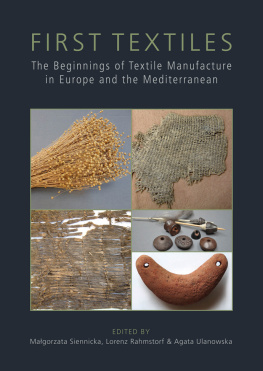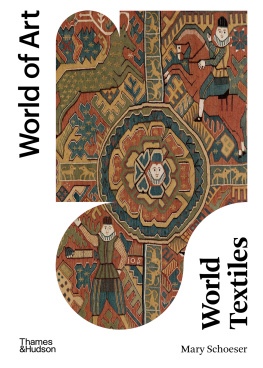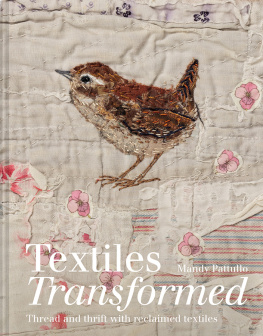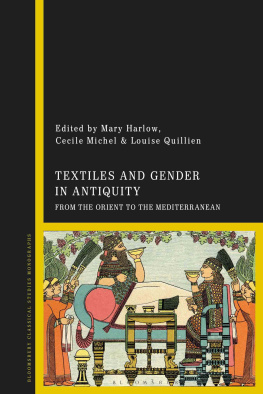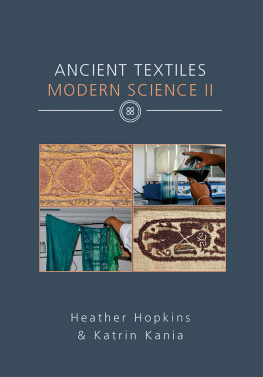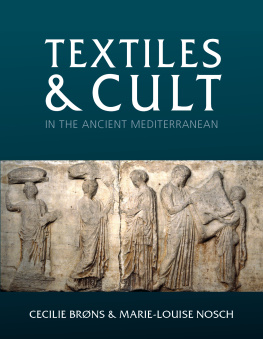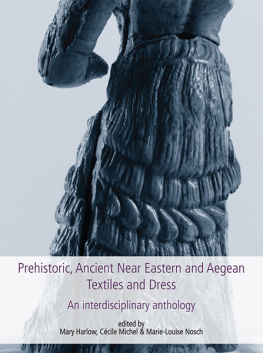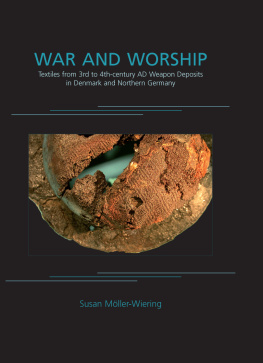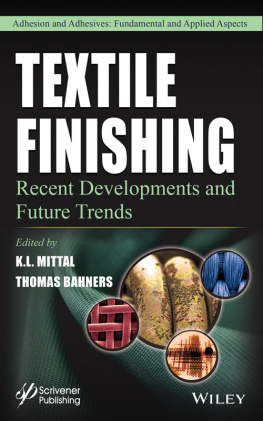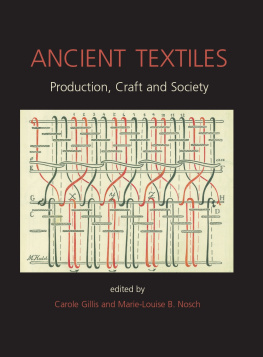Pagebreaks of the print version

ANCIENT TEXTILES SERIES 32
FIRST TEXTILES
THE BEGINNINGS OF TEXTILE MANUFACTURE IN
EUROPE AND THE MEDITERRANEAN
Proceedings of the EAA Session Held in Istanbul (2014) and the First Textiles Conference in Copenhagen (2015)
Edited by
MAGORZATA SIENNICKA, LORENZ RAHMSTORF
and
AGATA ULANOWSKA
Published in the United Kingdom in 2018 by
OXBOW BOOKS
The Old Music Hall, 106108 Cowley Road, Oxford, OX4 1JE
and in the United States by
OXBOW BOOKS
1950 Lawrence Road, Havertown, PA 19083
Oxbow Books and the individual authors 2018
Hardback Edition: ISBN 978-1-78570-798-8
Digital Edition: ISBN 978-1-78570-799-5 (epub)
eISBN 978-1-78570-799-5
Mobi ISBN 978-1-78570-800-8
A CIP record for this book is available from the British Library
Library of Congress Control Number: 2018958402
All rights reserved. No part of this book may be reproduced or transmitted in any form or by any means, electronic or mechanical including photocopying, recording or by any information storage and retrieval system, without permission from the publisher in writing.
For a complete list of Oxbow titles, please contact:
UNITED KINGDOM
Oxbow Books
Telephone (01865) 241249
Email:
www.oxbowbooks.com
UNITED STATES OF AMERICA
Oxbow Books
Telephone (800) 791-9354, Fax (610) 853-9146
Email:
www.casemateacademic.com/oxbow
Oxbow Books is part of the Casemate Group
Front cover : Flax (upper left corner) Agata Ulanowska; textile from Niederwil-Egelsee (upper right corner) Fabienne Mdard; textile from Feldmeilen (lower left corner) Fabienne Mdard; replicas of spindle whorls (small middle right) Agata Ulanowska; crescent-shaped loom weight from Tiryns (lower right corner) Magorzata Siennicka.

List of contributors
E VA A NDERSSON S TRAND () is Associate Professor of Textile Archaeology and director of the Centre for Textile Research, Saxo Institute, University of Copenhagen. Her publications range from Viking Age Scandinavia to the Bronze Aegean and Eastern Mediterranean and more particularly focus on the cultural, social and economic impact of textiles and textile production.
J OHANNA B ANCK -B URGESS () is a textile archaeologist at the State Office for Cultural Heritage, Baden-Wrttemberg in Esslingen. Her research deals with textile manufacture in prehistoric Central Europe, with a special focus on the Neolithic and Iron Ages.
N ECULAI B OLOHAN () is Assistant Professor in the Faculty of History at the Alexandru Ioan Cuza University of Iai. His research focuses on South-East Europe during the Bronze Age, pottery analysis and forensic archaeology.
I GNACIO C LEMENTE -C ONTE () is researcher at the Spanish National Research Council (CSIC-IMF) in Barcelona. His research interests comprise use-wear analysis, bone and lithic tools and high-mountain archaeology.
C ATARINA C OSTEIRA () holds a PhD in Archaeology from the University of Lisbon and currently works at the School of Arts and Humanities, UNIARQ Centre for Archaeology, University of Lisbon. Her research focuses on the Late Neolithic and Chalcolithic periods (4th /3rd millennia BC), prehistoric textiles and Chalcolithic pottery.
M IRIAM DE D IEGO () is a PhD candidate at the Department of Prehistory of the Universitat Autnoma de Barcelona (UAB). Her research interests include archaeology, ethnography, textile technology and use-wear analysis.
A XEL D IEDERICHSEN () is curator and research scientist in the Plant Gene Resources of Canada at the Saskatoon Research Centre, Agriculture and Agri-Food. His area of expertise is the characterisation, evaluation, maintenance, distribution and acquisition of plant germplasm of crop species and their wild relatives.
G IORGOS G AVALAS () is archaeologist at the Ephorate for Antiquities of the Cyclades of the Hellenic Ministry of Culture and Sports. He has been a collaborator in numerous excavation projects on the Cycladic Islands and extensively published, amongst other subjects, about prehistoric Cycladic textile tools, marble figurines and vessels.
A NA G RABUNDIJA () investigated textile tools from pile-dwellings in the pre-Alpine area after completing her thesis on Archaeological Evidence for Early Wool Processing in South East and Central Europe at the TOPOI A-4 research group (Textile Revolution). She is currently evaluating the impact of particular environmental and socio-cultural factors on technological adaptations, advancements and their transfer.
K ARINA T HERESIA G RMER () is a textile archaeologist at the Natural History Museum, Vienna (Department of Prehistory). She specialises in textile analysis, textile tools and reconstruction of prehistoric costume. Her current research focuses on the analysis of textiles from graves and salt mines, covering a time-span from 2000 BC until 1000 AD.
P ETYA H RISTOVA () is an independent scholar residing in the San Francisco Bay Area. She received her PhD from the University of California, Los Angeles and has excavated classical and prehistoric sites in Bulgaria. She works on ancient economy, craft specialisation, and interactions between ancient Thrace, Greece and other cultures of the eastern Mediterranean.
S IMON J EPPSON () is a doctoral student at the Department of Plant Breeding at the Swedish University of Agricultural Science in Alnarp.
S ABINE K ARG () currently leads a project in the Institute of Prehistoric Archaeology at the Freie Universitt Berlin about flax ( Linum usitatissimum L.), financed by the German Research Council (DFG).
C IPRIAN -C TLIN L AZANU () works at the Muzeul Judeean tefan cel Mare in Vaslui. His research focuses on Eastern Romania during the Bronze Age and further on bronze metallurgy.
R OMINA L AURITO () works at the Museo Nazionale Etrusco di Villa Giulia in Rome. Her expertise includes textile archaeology of the Near East and Etruria, as well as the study of seals and sealings.
J ANET L EVY () is affiliated with the Ben-Gurion University of the Negev in Israel. Her doctoral thesis was devoted to fibre and textile technologies and their significance in the development of formative villages in the Ancient Near East. Her research interests include prehistoric costume, music, dance, magic and shamanism in Antiquity and traditional societies.
U LLA M ANNERING () is a senior researcher at the National Museum of Denmark. Her primary area of research is prehistoric North European textile production and clothing, prehistoric plant fibre materials, experimental archaeology, clothing in iconographic sources, and Roman textiles. She is one of the initiators of the Danish National Research Foundations Centre for Textile Research (CTR) at the University of Copenhagen.
R UI M ATALOTO () holds a MA in Prehistory and Archaeology from the University of Lisbon and currently works for the Redondo Municipality. In his research, he focuses on the Late Neolithic and Bell Beaker period, society and economy.
F ABIENNE M DARD () has studied Fine Arts with special training as a conservator of art before specialising in archaeology and developing an interest in archaeological and ethnographic textiles. She holds a Ph.D. in prehistoric archaeology from the University of Paris X-Nanterre. She has directed projects focusing on Neolithic textile activities in western Europe, among others dedicated to the interactions between textile production and the environment.

